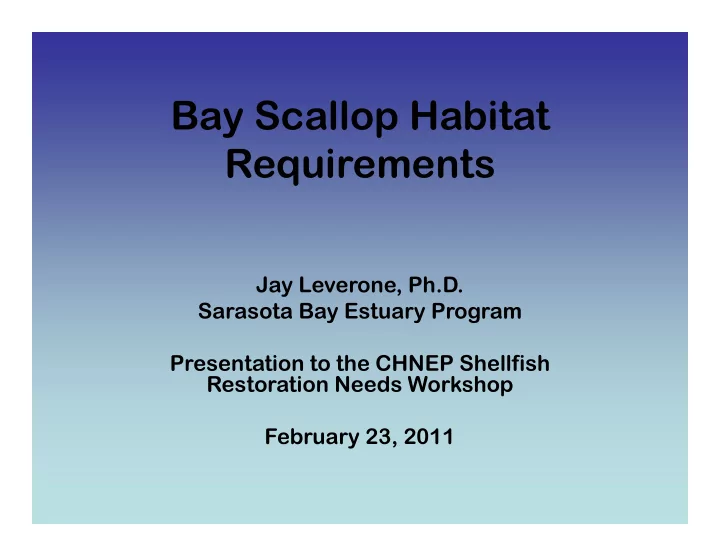

Bay Scallop Habitat Requirements Jay Leverone, Ph.D. Sarasota Bay Estuary Program Presentation to the CHNEP Shellfish Restoration Needs Workshop February 23, 2011
Bay Scallop Habitat Requirements • Bay scallops need seagrass to recruit, survive, grow and spawn! • Questions?
Bay Scallop Environmental Requirements (Leverone, 1993, MML Tech Rpt 253; Two articles in Fla. Sci. 58) • Water Quality – Temperature, Salinity, DO, • Food – Phytoplankton composition, chl, TSS • Reproduction • Habitat • Hydrodynamics • Harmful Algal Blooms (i.e., red tides)
Sources of Information • Results from a 1992-3 • Literature field and laboratory information most study Tampa Bay. appropriate for Florida populations • Requirements based of bay scallop on correlations of • Technical Report growth, mortality and “Literature Search reproduction with and Data Synthesis species-relevant on the Bay Scallop measures of water with Emphasis on quality Florida Populations”
References on relevant WQ and environmental conditions for the southern bay scallop PARAMETER REFERENCE Temperature Tettlebach & Rhodes, 81 Dissolved Oxygen Van Dam, 54; Shumway & Sandifer, 91 Salinity Tettlebach & Rhodes, 81 Food Supply Fegley et al., 92; Calahan et al., 89 Macrophyte Abundance Ambrose, 89; Prescott, 90; Eckman, 87 Current Speed Eckman et al., 87 Turbidity Stone & Palmer, 75 Suspended Solids Dyer, 75 Predators Peterson et al., 89
Unique Life History Differences for Florida Populations • Shorter life expectancy • Higher metabolic rates • Reproductive cycle occurs later in the year – Lower fecundity – Smaller egg size – Higher energetic cost of reproduction • Limits southern distribution and may accelerate senescence
Tampa Bay: Field Study • Deploy and maintain scallops at two sites – Beacon Key – Boca Ciega Bay • Two deployments – June (laboratory spawned) – August (wild scallops from Steinhatchee) • Collect relevant WQ data (biweekly) – Temperature, salinity, DO, turbidity, TSS, chl a, phytoplankton composition • Measure biological responses (biweekly) – Growth, mortality, reproductive development, fouling potential
Tampa Bay Stations
Scallop Growth
Temperature Ranges • Alligator Harbor populations: 9 – 32 o C (Sastry, 1965) • Anclote Harbor populations: 21 – 32 o C (Barber and Blake, 1985). • Tampa Bay populations: 23 – 31 o C
DO Record at Boca Ciega Bay (8/27 – 10/27/1992)
DO Record at Beacon Key (8/27 – 10/27/1992)
WQ at BCB ( ) and BK ( )
Phytoplankton Densities (cells/L)
Cumulative Percent Mortality
Reproductive Condition from Both Deployments
Tampa Bay: Laboratory Studies • Bay scallop responses to low DO at several temperature : salinity combinations (for 2 days) – DO: 1 – 5 mg/L – Temp: 25 – 35 o C – Salinity: 15 – 35 ppt • Returned to normoxic conditions and observed latent mortality • Measured “escape response”
Laboratory Results
Impacts of Karenia brevis on early life stages of Florida populations of bay scallop
Bay scallop larvae
Survival of 3-day old bay scallop larvae exposed to K. brevis and its toxins 100 a a a a a 96 b b ) l (% a iv 92 v r u S 88 84 Control W-10 L-10 W-100 L-100 W-1,000 L-1,000 Treatment
Survival of 7-day old bay scallop larvae exposed to K. brevis and its toxins 100 80 * 60 l a iv v r u S 40 20 0 Control 10 100 1,000 5,000 Karenia brevis (cells . ml -1 )
Conclusion from larval paper: “Special attention should be paid to blooms of K. brevis where these shellfish occur naturally or where aquaculture and restoration activities are either ongoing or planned.”
Juvenile bay scallops
Clearance rate of juvenile bay scallops exposed to K. brevis 14 a a 12 a Clearance Rate (ml . hr-1 . mg dry wt-1) 10 8 b b 6 b,c 4 c 2 0 Control Whole-10 Lysed-10 Whole-100 Lysed-100 Whole-1,000 Lysed-1,000 Treatment
Clearance rate of juvenile scallops exposed to whole K.brevis under flow-through conditions 5 Control 100 cells/ml 1,000 cells/ml a a a a a 4 . hr -1 . mg dry wt -1 ) b 3 b b b b Clearance Rate (ml b b b b 2 c 1 0 Day 1 (PM) Day 2 (AM) Day 2 (PM) Day 3 (AM) Day 3 (PM) Day/Time
Clearance rate of juvenile scallops exposed to lysed K.brevis under flow-through conditions 4 Control 100 cells/ml a a a 1,000 cells/ml a a b b b . hr -1 . mg dry wt -1 ) 3 b Clearance Rate (ml 2 b b c 1 0 Day 1 (AM) Day 1 (PM) Day 2 (AM) Day 2 (PM) Day/Time
Conclusion from juvenile paper: “The prospect for recovery of bay scallop populations in Florida estuaries where they were once abundant may be hampered by recurring blooms of K. brevis .”
Optimal Ranges for Florida Bay Scallops WATER QUALITY TARGET PARAMETER 25 – 30 o ideal; not to exceed 32 o for prolonged periods Temperature (Bottom) Salinity (Bottom) Greater than 20 ppt (24 – 30 optimal) DO (Bottom) Not less than 2 mg/L for less than 2 hours Turbidity 5 – 10 NTUs Total Suspended Solids Less than 40 mg/L TSS/VSS Ratio Greater than 1.282 (inorganic C % of seston < 78%) Chlorophyll a 5 – 10 μ g/L Phytoplankton Density: less than 5 x 106 cells/L; Species; blooms harmful; Karenia breve fatal. Seagrass Thalassia / Syringodium mix ideal. Density: > 75 shoots/m2; Continuous seagrass beds preferred.
Recommend
More recommend